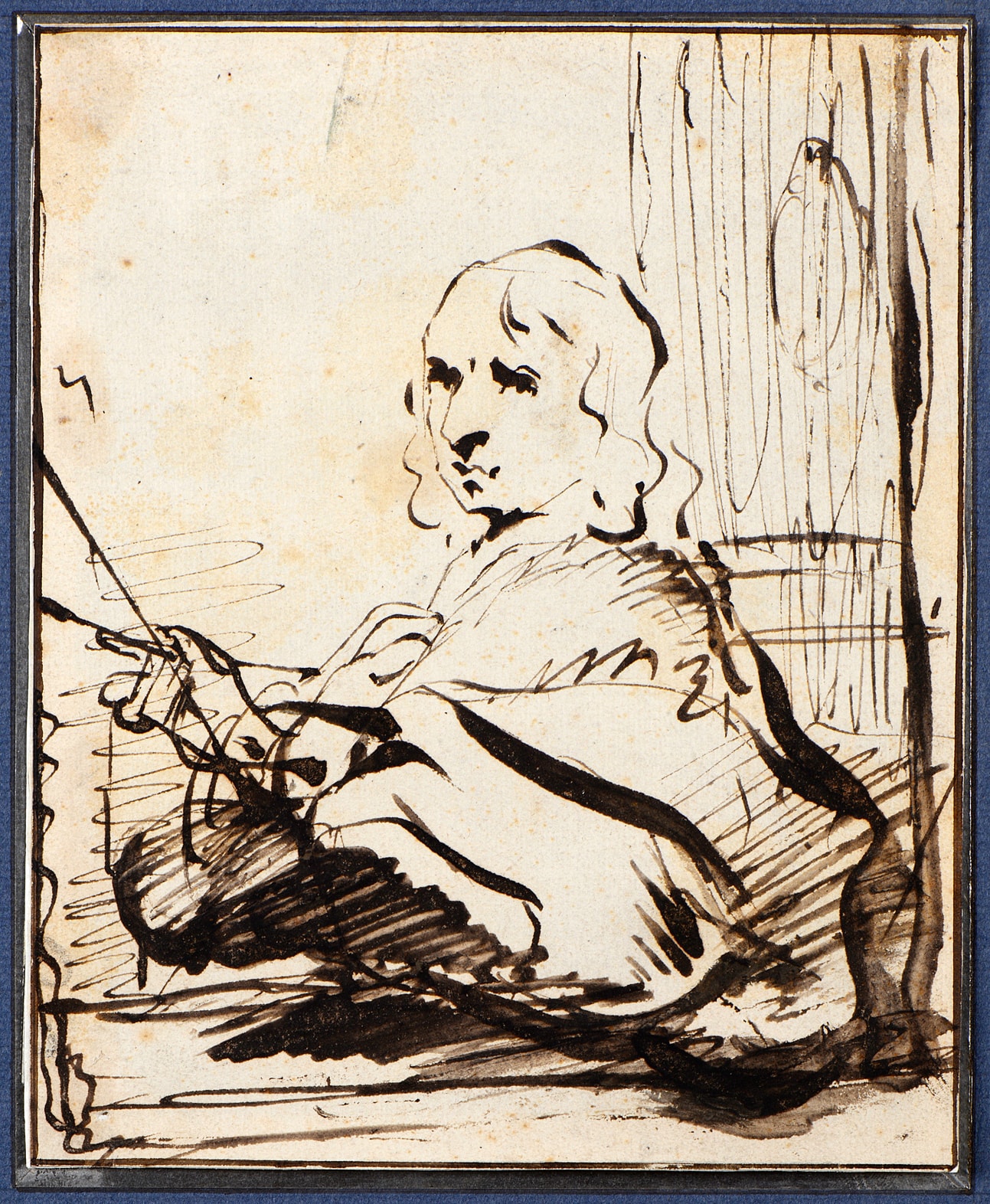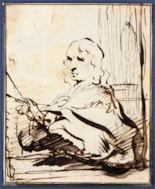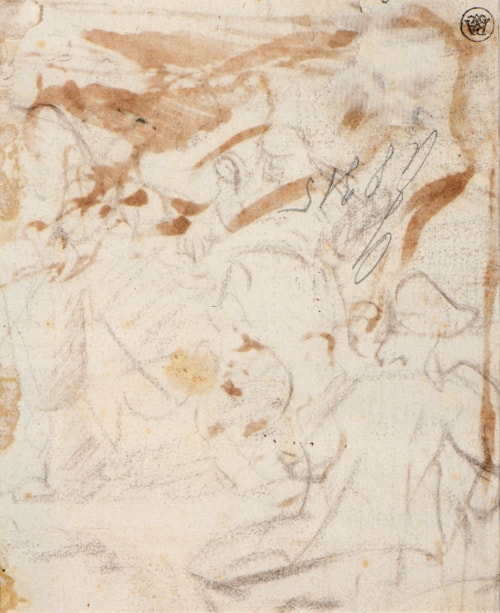Govert FLINCK
(Kleve 1615 - Amsterdam 1660)
Portrait of a Painter, possibly a Self-Portrait
Sold
Pen and brown ink, with brown ink framing lines.
A (Biblical?) scene, with three or four figures (Christ teaching?), faintly sketched in black chalk on the verso.
166 x 136 mm. (6 1/2 x 5 3/8 in.)
A (Biblical?) scene, with three or four figures (Christ teaching?), faintly sketched in black chalk on the verso.
166 x 136 mm. (6 1/2 x 5 3/8 in.)
Only a handful of portrait drawings by Govert Flinck are known. Drawn with a quick and spontaneous pen line, the present sheet may be dated to the second half of the 1650s, and shows the influence on the artist of the pen drawings of Rembrandt. Among stylistically comparable pen and ink drawings by Flinck is a half-length study of an archer, in the collection of the Herzog Anton Ulrich-Museum in Braunschweig and a drawing of a Woman Seated at a Table in the Louvre. In his magisterial corpus of Flinck’s drawings, Werner Sumowksi further likens the present sheet to a signed and dated drawing of a Scholar in his Study of 1656, in the Heyblocq album amicorum in the collection of the Koninklijke Bibliotheek in The Hague, as well as to pen and ink drawings by Flinck of an Old Man Seated in the National Gallery of Victoria in Melbourne, a Standing Young Man with a Hat in the Louvre and a Young Man with a Staff in the Nasjonalgalleriet in Oslo.
The painter in this drawing is shown holding a mahlstick, paintbrush and palette, with what seems to be another palette hanging on the wall behind him. The attitude of the sitter, who looks directly at the viewer, gives the drawing the manner of a self-portrait, and indeed there is a certain physiognomical resemblance with Flinck’s self-portrait in the left background of his large canvas of The Civil Guard of Amsterdam Celebrating the Peace of Westphalia, painted in 1648 and today in the Amsterdam Museum in Amsterdam, as well as with a self-portrait of 1643, long thought to be lost and today in the Leiden Collection in New York. Similarities may also be noted with an oval portrait of Govert Flinck by Gerard Pietersz. van Zijl, which was engraved by Abraham Blooteling. Although the identification of the sitter of this drawing as Flinck himself was accepted by Frits Lugt, H. van Hall and Jeroen Giltaij, Werner Sumowski does not believe the present sheet is a self-portrait.
The very faint sketch in black chalk on the verso of the present sheet shows what appears to be a Biblical scene, which Sumowksi has suggested may represent Joseph’s Bloodstained Cloak Shown to Jacob or Potiphar’s Wife Accusing Joseph. If it is the former, then it may possibly be related to both a drawing of this subject, in the Musée Fabre in Montpellier, and a painting, dated 1655, which is today in the Sinebrychoff Art Museum of the Finnish National Gallery in Helsinki.
The painter in this drawing is shown holding a mahlstick, paintbrush and palette, with what seems to be another palette hanging on the wall behind him. The attitude of the sitter, who looks directly at the viewer, gives the drawing the manner of a self-portrait, and indeed there is a certain physiognomical resemblance with Flinck’s self-portrait in the left background of his large canvas of The Civil Guard of Amsterdam Celebrating the Peace of Westphalia, painted in 1648 and today in the Amsterdam Museum in Amsterdam, as well as with a self-portrait of 1643, long thought to be lost and today in the Leiden Collection in New York. Similarities may also be noted with an oval portrait of Govert Flinck by Gerard Pietersz. van Zijl, which was engraved by Abraham Blooteling. Although the identification of the sitter of this drawing as Flinck himself was accepted by Frits Lugt, H. van Hall and Jeroen Giltaij, Werner Sumowski does not believe the present sheet is a self-portrait.
The very faint sketch in black chalk on the verso of the present sheet shows what appears to be a Biblical scene, which Sumowksi has suggested may represent Joseph’s Bloodstained Cloak Shown to Jacob or Potiphar’s Wife Accusing Joseph. If it is the former, then it may possibly be related to both a drawing of this subject, in the Musée Fabre in Montpellier, and a painting, dated 1655, which is today in the Sinebrychoff Art Museum of the Finnish National Gallery in Helsinki.
Govert (or Govaert) Flinck was a pupil of the Mennonite preacher and artist Lambert Jacobsz in Leeuwarden, alongside Jacob Backer, who was a few years older. The two young artists then travelled together to Amsterdam, where Flinck worked in the workshop of the art dealer Hendrick Uylenburgh. It was probably there that he met Rembrandt, who also worked for Uylenburgh. Flinck spent about a year in Rembrandt’s studio, probably between 1635 and 1636, working alongside artists such as Ferdinand Bol, before becoming an independent master. While his paintings of the mid-1630s and early 1640s are much indebted to Rembrandt’s manner (indeed, several of his portraits were once attributed to the master), by the later 1640s he had begun to paint in a lighter, more classical and courtly style and had secured a reputation as one of the foremost portrait and history painters in Amsterdam. Flinck received a number of important public commissions in the 1640s, and also was much in demand as a portrait painter. By the end of the 1650s he was enjoying a reputation as arguably the leading society painter in Amsterdam, culminating in a commission for twelve history paintings to decorate the Amsterdam Town Hall. His sudden death in 1660, at the age of just forty-five, came at the very height of his highly successful and lucrative career.
As a draughtsman, Govert Flinck produced around 120 drawings; mainly individual life studies of both nude and clothed male or female figures, drawn in black and white chalk on blue paper, as well as landscapes, Biblical scenes and portraits. While most of Flinck’s extant drawings are in black chalk (and, occasionally, red chalk), drawings in pen and ink - both with and without wash - are relatively few in number. Almost all of Flinck’s surviving drawings can be dated to the years following his apprenticeship with Rembrandt. His earliest signed and dated drawing - a standing man in Eastern costume, drawn in 1638 - is in fact his only known dated drawing from the decade of the 1630s.
Provenance
Vicomte Bernard d’Hendecourt, Paris
His sale, London, Sotheby’s, 8-10 May 1929, lot 248 (as School of Rembrandt), bt. Beets for £20
Iohan Quirijn van Regteren Altena, Amsterdam (his posthumous sale stamp [Lugt 4617] on the verso).
Literature
Frits Lugt, Musée du Louvre: Inventaire général des dessins des écoles du Nord. École Hollandaise, Vol.III; Rembrandt, ses élèves, ses imitateurs, ses copistes, Paris, 1933, p.60, under no.1314 (as a self-portrait); H. van Hall, Portretten van Nederlandse beeldende kunstenaars: Portraits of Dutch painters and other artists of the Low Countries. Specimen of an Iconography, Amsterdam, 1963, p.100, Flinck no.14 (as a self-portrait); Joachim Wolfgang von Moltke, Govaert Flinck 1615-1660, Amsterdam, 1965, p.201, no.D147 (where dated to the second half of the 1650s); Werner Sumowski, ‘Eine frühe Federzeichnung von Govaert Flinck’, Pantheon, October 1967, p.340, notes 2 and 8; Jeroen Giltaij, Le cabinet d’un amateur: Dessins flamands et hollandaises des XVIe et XVIIe siècles d’une collection privée d’Amsterdam, exhibition catalogue, Rotterdam and elsewhere, 1976-1977, pp.30-31, no.51, illustrated pl.77 (as a self-portrait); Werner Sumowski, Drawings of the Rembrandt School, Vol.IV, New York, 1981, pp.2116-2117, no.966X (where dated c.1655), also p.2076, under no.948bx, p.2114, under no.965x and p.2122, under no.969x; Thomas Döring, Aus Rembrandts Kreis: Die Zeichnungen des Braunschweiger Kupferstichkabinetts, exhibition catalogue, Braunschweig, 2006, p.54, under no.15.
Exhibition
Leiden, Stedelijk Museum de Lakenhal, Rembrandt als Leermeester, 1956, no.127; Cleves, Städtisches Museum Haus Koekkoek, Govert Flinck, der Kleefsche Apelles 1616-1660, 1965, no.62; Rotterdam, Museum Boymans-van Beuningen, Paris, Institut Néerlandais and Brussels, Bibliotheque Albert Ier, Le cabinet d’un amateur: Dessins flamands et hollandaises des XVIe et XVIIe siècles d’une collection privée d’Amsterdam, 1976-1977, no.51.





